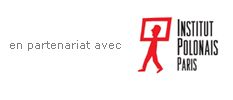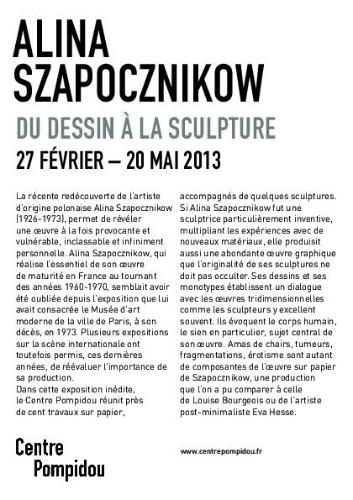Exhibition
Alina Szapocznikow
Du dessin à la sculpture
27 Feb - 20 May 2013
27 Feb - 20 May 2013

The event is over

The work of Alina Szapocznikow (1926-1973) is to be found here and there in the museums of her native land, Poland. However, her adoptive home of France seems to have forgotten her since the exhibition devoted to her by art critic Pierre Restany on her death in 1973. Today, Centre Pompidou once again returns to her drawings, hosting an exceptional exhibition bringing together close to one hundred works on paper, along with a number of sculptures. After the invasion of Poland by the Nazis, the Jewish Szapocznikow family was shut up in the ghettos of Pabianice and then Lodz before being interned in Auschwitz and subsequently Bergen-Belsen. As a teenager, Alina worked in the camp as a nurse alongside her mother, who was a doctor. At the end of the war, she went to Prague, where she learned sculpture with Josef Wagner. In 1947, she decided to go to Paris and its School of Fine Arts to continue her studies. Her return to Poland in 1951 marks the start of her official career and significant commissions. After having represented Poland at the Venice Biennial in 1962, Alina Szapocznikow once again left her native land for France. It was in Paris that her work was to blossom fully. She experimented with new materials, including polyurethane foam and polyester resin. Like Rodin in his day, she dismembered the human body – her own – and it was to become her subject of choice. In early 1969, Alina Szapocznikow contracted breast cancer. Between then and her death in 1973, she went through a period of intense creative activity. The series of ten or so Fetishes, made using moulds of body parts and random items dates from this period. Like many other sculptors, Alina Szapocznikow also left drawings. These focus on the human body, especially her own, which was the central subject of her work. The proper catalogue of her work runs to 620 drawings, including academic studies. Some are sketch drawings for a particular sculpture, while others are freer. Characterised by what Pierre Restany refers to as “disembodiment of form,” her most productive period dates from her years in Paris before illness struck (1963-1968), during which she produced her very best drawings. A final sequence (1969-1973) sees the appearance of colour in a more dreamlike world, recalling that of surrealism. The exhibition begins with drawings from her early career before moving on to focus on her years in Paris. The organic and sculptural forms and technical experiments from this period gave rise to outstanding works of graphic art. The exhibition gives pride of place to Centre Pompidou’s new acquisitions – more especially, five drawings and one sculpture, Fétiche II (1970-1971). These works have entered the museum’s collection through the generosity of the Society of Friends of the National Museum of Modern Art.

The work of Alina Szapocznikow (1926-1973) is to be found here and there in the museums of her native land, Poland. However, her adoptive home of France seems to have forgotten her since the exhibition devoted to her by art critic Pierre Restany on her death in 1973. Today, Centre Pompidou once again returns to her drawings, hosting an exceptional exhibition bringing together close to one hundred works on paper, along with a number of sculptures.
After the invasion of Poland by the Nazis, the Jewish Szapocznikow family was shut up in the ghettos of Pabianice and then Lodz before being interned in Auschwitz and subsequently Bergen-Belsen. As a teenager, Alina worked in the camp as a nurse alongside her mother, who was a doctor. At the end of the war, she went to Prague, where she learned sculpture with Josef Wagner. In 1947, she decided to go to Paris and its School of Fine Arts to continue her studies. Her return to Poland in 1951 marks the start of her official career and significant commissions. After having represented Poland at the Venice Biennial in 1962, Alina Szapocznikow once again left her native land for France. It was in Paris that her work was to blossom fully. She experimented with new materials, including polyurethane foam and polyester resin. Like Rodin in his day, she dismembered the human body – her own – and it was to become her subject of choice. In early 1969, Alina Szapocznikow contracted breast cancer. Between then and her death in 1973, she went through a period of intense creative activity. The series of ten or so Fetishes, made using moulds of body parts and random items dates from this period.
Like many other sculptors, Alina Szapocznikow also left drawings. These focus on the human body, especially her own, which was the central subject of her work. The proper catalogue of her work runs to 620 drawings, including academic studies. Some are sketch drawings for a particular sculpture, while others are freer. Characterised by what Pierre Restany refers to as “disembodiment of form,” her most productive period dates from her years in Paris before illness struck (1963-1968), during which she produced her very best drawings. A final sequence (1969-1973) sees the appearance of colour in a more dreamlike world, recalling that of surrealism. The exhibition begins with drawings from her early career before moving on to focus on her years in Paris. The organic and sculptural forms and technical experiments from this period gave rise to outstanding works of graphic art. The exhibition gives pride of place to Centre Pompidou’s new acquisitions – more especially, five drawings and one sculpture, Fétiche II (1970-1971). These works have entered the museum’s collection through the generosity of the Society of Friends of the National Museum of Modern Art.
Where
Musée - Niveau 4 - Galerie d'art graphique
When
27 Feb - 20 May 2013
11am - 9pm, every days except tuesdaysPartners


